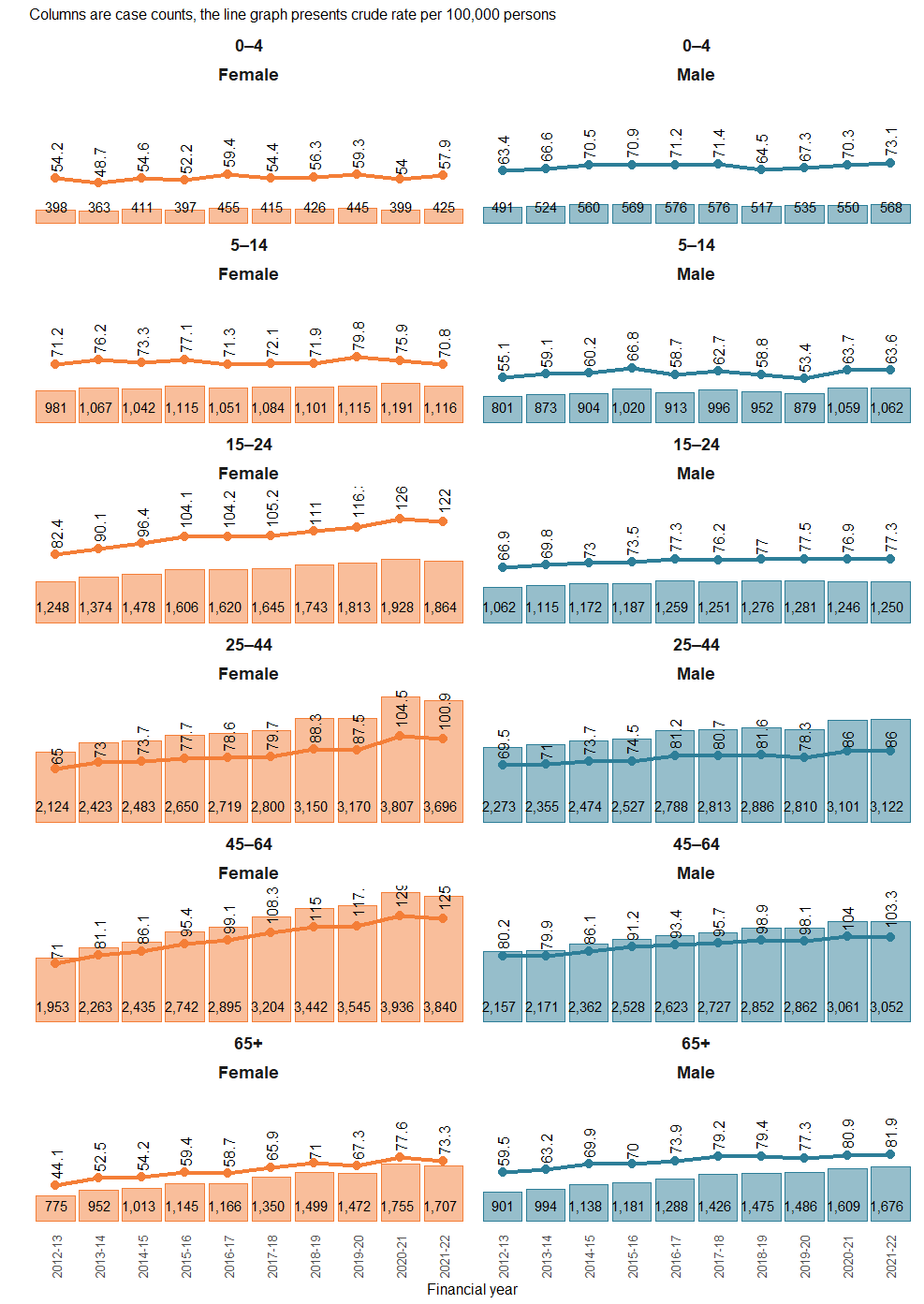Who is injured?
In 2021-22, females constituted 54% of injury cases hospitalised due to contact with animals. Nearly 3 out of 5 cases were adults aged between 25 and 64 years, and under 13% were children aged under 15 years. The highest crude rate was among females aged 15-24 at 123 per 100,000 (Table 1).
| Age group (b) | Cases: Male | Cases: Female | Cases: Persons (e) | Crude rate(a) Male | Crude rate(a) Female | Crude rate(a) Persons |
|---|---|---|---|---|---|---|
| 0–4 | 568 | 425 | 993 | 73 | 58 | 66 |
| 5–14 | 1,062 | 1,116 | 2,178 | 64 | 71 | 67 |
| 15–24 | 1,250 | 1,864 | 3,115 | 77 | 123 | 99 |
| 25–44 | 3,122 | 3,696 | 6,818 | 86 | 101 | 94 |
45–64 | 3,052 | 3,840 | 6,892 | 99 | 120 | 110 |
65+ | 1,676 | 1,707 | 3,383 | 82 | 73 | 77 |
| Total | 10,730 | 12,648 | 23,379 | 83.6 | 97.1 | 90.4 |
Notes:
(a) Crude rate is per 100,000 persons
(b) Records where age is missing are excluded from this table
(c) Records where remoteness is missing are excluded from this table
(d) Remoteness is based on the remoteness of usual place of residence for the patient
(e) Persons include records where sex is missing, intersex or indeterminate. Therefore, sum of male and female components may not equal the persons count.
(f) Total is the grand total. This includes records where age or remoteness are missing. Therefore, the sum of the age group components or sum of the remoteness components may not equal the total.
Source: National Hospital Morbidity Database
Over the 10 years described in this report, the largest increases in numbers of injury hospitalisations occurred for cases aged 15+, with generally more females than males hospitalised. The gender gap was widest for 15–64-year-olds and narrowest for people aged 65+. The largest increase in numbers of hospitalisations occurred between 2019-20 and 2020-21 (Figure 4, Figure 3).
Crude rates of injury hospitalisation generally increased over the decade for most age groups. The gender gap was widest for 15–24-year-olds and widening over time, with females (122.7 per 100,000) in this age group hospitalised at nearly 1 and a half times the rate of corresponding males (77.3 per 100,000) by 2021-22. At the extremes of age (0-4 and 65+ year olds) the gender preponderance was flipped, with a higher rate of hospitalisation among males (Figure 4).
Injury hospitalisations by categories of animals are described further in the ‘Type of animals’ section of this report.
Figure 4: Increases in numbers and crude rates of injury hospitalisations related to contact with animals varied by age group and gender across Australia, 2012-22

Source: National Hospital Morbidity Database
For more information please refer to supplementary data table 2.
In 2021-22, about 900 0–4-year-olds were hospitalised with injuries caused by contact with animals, a rate of 65.7 per 100,000. This was the lowest rate of hospitalisation for any age group.
- Boys had higher rates of hospitalisation than girls (73 and 58 per 100,000 respectively).
- Most children were injured by contact with pets (63.6% or 41.8 per 100,000 cases), followed by wildlife (28.4% or 18.7 per 100,000 cases).
- Head and neck injuries were more common in 0–4-year-olds than other age groups; over half of 0–4-year-olds sustained a head and neck injury and about two thirds of these head and neck injuries involved open wounds (Figure 21).
Crude rates of injury were similar for 0-4- and 5–14-year-olds across the decade (Figure 4). More males aged 0-4 and more females aged 5-14 were hospitalised.
While we are unable to drill down to specific occupation, 2021-22 hospitalisation data indicated 2,978 injuries occurred while working. Of the almost half of cases that had a place of occurrence recorded:
- over half occurred in homes (866 cases) of which,
- 81 occurred while working for an income
- 785 occurred while engaged in other types of work.
- 208 cases (13%) occurred on commercial, industrial or construction sites
- 169 cases (10%) occurred in sports or athletic arenas.
Of the 1,699 cases injured whilst working for an income, a third (572 cases) were among people working in the agriculture, forestry or fishing sectors.
Injury hospitalisations by type of animal and work, 2021-22
-
Common pets were associated with 823 hospitalised injuries
-
- 294 (36%) cases engaged in caring, gardening, or other household work
- 217 (26%) engaged in specified work for income
- 187 (23%) engaged in health services
-
Livestock were associated with 1,038 hospitalised injuries
-
- 434 (42%) cases from the agriculture, forestry and fishing industries
- 271 (26%) engaged in specified work for income
- 222 (21%) engaged in caring, gardening, or other household work
-
Wildlife were associated with 1,011 hospitalised injuries
-
- 721 (71%) cases engaged in caring, gardening, or other household work
- 88 (9%) engaged in specified work for income
- 84 (8%) from the agriculture, forestry and fishing industries
-
Marine animals were associated with 33 hospitalised injuries, with 18 (55%) of these from the agriculture, forestry and fishing industries
-
For 73 hospitalised injuries the type of animal was unspecified
-
- 34 (47%) were engaged in caring, gardening, or other household work
- 24 (33%) were from the agriculture, forestry and fishing industries
-
For 2,978 injury hospitalisations both an animal and occupation were recorded.
-
- 1,279 (43%) were engaged in caring, gardening, or other household work
- 1,699 (57%) were working for an income
- 572 (19%) were from the agriculture, forestry and fishing industries


